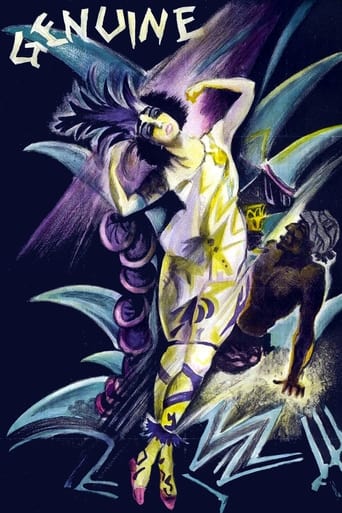Dalbert Pringle
Regardless of this silent-era picture now being almost 100 years old, it's still not worth more than a 2-star rating, in my books.Believe me, this German export was pretty bloody awful (even when I took into account it being a product of cinema's by-gone days).For one thing - Had the leading actress, Fern Andra (who played the title character, Genuine) been even marginally attractive, then, yes, that would've certainly helped this nonsensical film at least rise above its sub-par mediocrity.But this actress (with her frizzy hair and bug eyes) had to be one of the absolute, most dog-ugly dames imaginable, regardless of the era of fashion that she represented.It's especially when you take into consideration that the Genuine character was supposed to be an irresistible seductress (aka. vamp-ire), where all the men were literally falling head-over-heels in love with her (and actually quite willing to commit murder, if she so commanded) that her decidedly cheap and somewhat creepy looks rendered her (along with the rest of the movie) as being repulsive rather than attractive.Besides not being even slightly entertaining (even from a nostalgic point of view), I found this moldie-oldie, with its ridiculously exaggerated acting, to be nothing but a stale, old joke told in very bad taste.Thank goodness this film only had a running time of just 43 minutes.
MartinHafer
partial nudity This film is currently available from archive.org, as it's in the public domain. And, it is the 43 minute version.Apart from the unusual set and costume design that has been influenced by the German Expressionist movement, there isn't a lot to this film I would recommend. In fact, I think it's all kind of silly and trite. The story is about an irresistible woman named 'Genuine' and she apparently is so hot and wonderful that men MUST do her bidding. And, when she asks them to kill others or themselves, they do in order to prove their love and obedience towards her. This strange plots combined with LOTS of overacting (especially in the lovemaking scenes) make for a movie that is bizarre and pretty silly. I was not all that impressed and think the film won't interest anyone but the most ardent silent movie fans. Now I am probably among the most prolific reviewers of silents, and it didn't interest me a whole lot either! By the way, like many films (particularly European ones) of this era, there is some partial nudity in this film that might surprise you. Sadly, even this wasn't enough to generate any excitement in this film!
MARIO GAUCI
I’ve been wanting to give this a whirl ever since acquiring it six years ago – as part of the Kino edition of the same director’s THE CABINET OF DR. CALIGARI (1920). However, the result (without taking into account its obvious narrative gaps, being incomplete in this version) is nowhere near as groundbreaking or even compelling as that earlier classic – despite the comparable Expressionist look (including a clock standing in for the face of a skeleton[!] and which is still its best quality).The plot revolves around a femme fatale called Genuine – hence, the vampire of the title is not of the blood-sucking variety – who had actually been the high priestess of some cult. Due to a clash between factions, she ends up in a slave market (featuring surprising but discreet nudity) and is eventually bought by an eccentric old man (among other things, he likes to doze off while being shaved daily!), who keeps the girl in the cellar of his ‘notorious’ mansion so as to shelter her from the vices of modern life; incidentally, one is never quite sure in which era this is all supposed to be taking place – since the dapper but doddering old man has an Arab, with painted bare chest, for a servant! The irony, then, is that the girl’s own nature – she has a feral countenance and wears a skimpy striped outfit! – is infinitely more dangerous to the young men she enslaves (one of whom sports a highly anachronistic Duran Duran hairdo!). These, in fact, are somehow driven mad (as it stands, the details aren’t very clear – particularly with respect to the old man’s nephew); when the son of his exclusive barber is similarly afflicted, the latter rouses the populace against her and – in a scene which basically replicates Cesare the somnambulist’s fate from the aforementioned THE CABINET OF DR. CALIGARI – she dies in the ensuing pursuit.In conclusion, the treatment afforded the film isn’t sufficiently gripping to rate it higher than a mere curio at this juncture; besides, it’s all the more disappointing coming from Wiene (who, besides CALIGARI also made the equally influential THE HANDS OF ORLAC [1924]). By the way, another interesting effort of his – the Dostoyevsky adaptation RASKOLNIKOV (1923) – will soon be released on DVD by the budget label Alpha (under the alternate title of CRIME AND PUNISHMENT)…
jpierson-2
I've just viewed the Image DVD of CALIGARI, with commentary by Mike Budd. This DVD also includes excerpts from GENUINE. While the snippets included are pretty strange and disconnected, they show a major similarity between the two films -- that is, the "frame" structure of the story. CALIGARI's frame is that it is a story told by a madman. In GENUINE, it appears that the story is a "dream" experienced by a young man who has fallen asleep reading his favorite novel. What I saw of GENUINE makes it seem the young man's favorite author was Sacher-Masoch. See also how Genuine messes up the young man's hair in a rush of passion -- shades of John Barrymore's transition scenes from DR. JEKYLL AND MR. HYDE?

